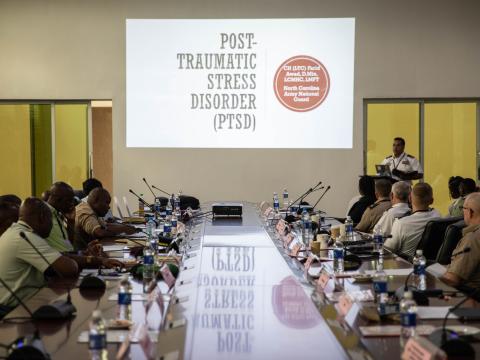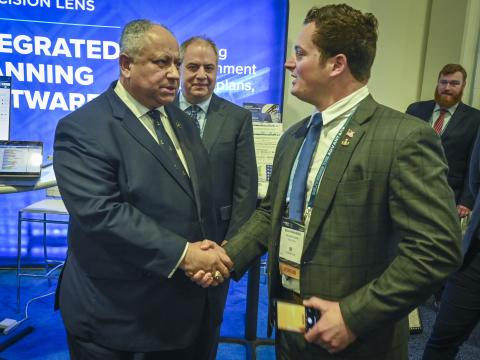Beware the Black Hole: Unraveling the Gravity of Disinformation in Space Exploration
In an era dominated by rapid information flows, the negative impact of misleading, manipulated or false information has affected several industries, sowing dangerous chaos and confusion. From political landscapes to public health crises, disinformation is a destabilizing force, distorting reality and undermining trust. As disinformation campaigns leverage emerging technology, the potential consequences become increasingly severe. One area where disinformation could cause serious damage is the space domain. The intersection of cutting-edge technology and global collaboration is particularly vulnerable to the disruptive impact of manipulated information.
Not long ago, outer space was the exclusive domain of a few wealthy governments and the handful of contractors that supported them. Launches of humans or materials into space became a common occurrence that sometimes garnered public attention. The commercialization of space capabilities brought not only new players in space but the emergence of a new economy. As the cost per kilogram to launch people and materials into space dropped, new commercial players entered the market democratizing information from space-based sensors. This expansion prompted calls to designate space as critical infrastructure, manage the creation of space debris and integrate space capabilities into more terrestrial activities. After all, there would be no market for space capabilities without earthlings to pay for their services.
As space-based data and services become more integrated with terrestrial consumers and as policymakers and business leaders strive to better define this new domain, the potential for disinformation to erode the investment in space capabilities should be a core consideration. Space policymaking has already addressed issues like space cybersecurity (SPD-5, National Space Policy, DHS Space Policy) and space traffic management (SPD-3). There is a clear gap in how disinformation in the space domain is considered, but the potential impact could have enormous economic, national and homeland security implications.
Between 1957 and 2010, humanity launched a total of 997 satellites into orbit. Between 2021 and 2022 alone, there were 2,105 launches of new operational satellites. As of January 2024, the number stands at 7,560. From communications to Earth observation, more people have easier and cheaper access to services once reserved only for military or intelligence use. Currently, few people question the provenance or authenticity of space-based data. The GPS signal is often taken as infallible, and satellite phones are assumed to work from anywhere with a view of the sky. But what would result from a loss of confidence in data from space? How difficult would that be to engineer? Could we recover?
To answer these questions, let’s explore disinformation and how it’s been used for malicious intent. Disinformation, characterized by the intentional spread of false or misleading information, can take many forms but aims to deceive or manipulate to achieve political, military or financial goals. It entered a new frontier in the digital age with the advent of sophisticated tools like deepfakes. Deepfakes, AI-generated content that convincingly alters or fabricates visual or audio material, have emerged as potent instruments in the disinformation landscape. Bad actors are already using deepfakes across sectors including finance, healthcare and politics to spoof voices of high-profile individuals and manipulate content for the purposes of transferring funds, providing sensitive information and shifting public opinion.
So how might disinformation be used against space entities?
In the early weeks of Russia’s invasion of Ukraine, many amateur geospatial intelligence (GEOINT) analysts rallied to find ground truth. One of the enduring images was the long convoy of Russian soldiers and equipment stuck along a single road in Ukraine. Amateur analysts publicized pictures of the convoy, its location, and even its composition. In military terms, this is a goldmine of information that would enable quick and accurate strikes against an immobile target that could cripple an invading force in the earliest days. But the opposing force could also use this kind of information for denial and deception operations.
An attack against a popular Earth observation satellite could have enormous implications in a number of fields, but in the example of military action, could lure the defending force away from the invader’s critical supply chain or into an ambush. A cyber attack that spoofs the sensor’s output to the consumers on the ground could obfuscate ground truth using a tool that many consider the “most true” because it is a photograph of conditions on the ground. Spoofing data could not only cost lives but could also irreparably harm the reputation of the veracity of commercial Earth observation capabilities. A harm to the reputation of one such service would have direct economic impact on the companies in question, but also has a high potential to spread into other types of space-based data. Further complicating the issue, the physical distance between the terrestrial consumer and the asset producing the data precludes any kind of inspection or easy replacement. The satellite(s) then become another piece of space debris as consumer confidence fades.
The “attack” in question need not necessarily be a cyber attack but could be a coordinated disinformation attack. False or doctored Earth observation images could be produced and publicized to create the same effect. If consumers believe their analysis could have led to the ambush of Ukrainian forces, the belief could lead to a viral message to discontinue using a specific service. The sudden appearance of skepticism around what was once unquestionably true would likely spread to other types of space-based information. How do we know information from this hunk of metal 500 kilometers high is correct? That question could impact not just amateur GEOINT analysts but things like climate science (already the target of disinformation). In this era of deepfakes, people are already learning to question what they see. This phenomenon could easily extend to space-based capabilities with potentially devastating effects on the commercial space industry as a whole.
Disinformation is already a preferred weapon for adversaries who see strategic gain in longer-term, less-attributable ways to disrupt specific capabilities or generally sow chaos. The growth of the space domain and its widening impact on terrestrial capabilities makes it an increasingly attractive target for adversary action. Launching anti-satellite weapons from Earth is noisy and likely to draw international ire due to debris creation. Cyber attacks are a great option for direct action but may also be attributed, as in the case of Russia’s hack of Viasat. Disinformation campaigns may end up being a preferred weapon for space domain disruption because eroding trust in the veracity of data of a sensor that is hundreds or thousands of kilometers away may not be that difficult, particularly if it is possible to undermine direct photographs of conditions on the ground and cast doubt about whether these images can be relied upon for tactical, operational or strategic decisions. The effects are tantamount to bricking the on-orbit sensor without a destructive cyber attack if consumers no longer trust its output. Finally, there is an economic effect as the development, launch and operational costs will be sunk if paying consumers leave the platform. That’s a lot of incentive to undertake a very low-risk operation.
Disinformation also poses a threat that extends beyond military considerations. Space-enabled scientific research could transform biological exploration, drug development and manufacturing on Earth. Several organizations are investing significant resources to develop new manufacturing approaches or materials that are only possible in space. Given how disinformation campaigns have already harmed medical advancements like vaccine uptake, it’s not hard to imagine how a disinformation campaign could diminish or confuse the benefits of a groundbreaking scientific finding in space. False narratives, doctored images or misleading information circulated through various channels could create skepticism among the public, scientific community and policymakers. The potential consequences are profound—a disinformation campaign could undermine public trust in the legitimacy of scientific breakthroughs, impede further exploration efforts, limit Earth’s exponential benefits and even hinder the allocation of resources for future space initiatives.

Bad actors using disinformation campaigns to their benefit is inevitable. How do we mitigate their impact when it comes to space-related endeavors? It will require a multifaceted approach revolving around policy, education and international cooperation. Our recommended checklist to researchers and policymakers is as follows:
- Promote international collaboration and information sharing: Participate in international collaborations to share information and intelligence related to space activities.
- Develop space information authentication standards: Work with space agencies, industry stakeholders and international partners to establish standardized protocols for authenticating and verifying information originating from space-based assets.
- Invest in space education and literacy programs: Allocate resources for educational initiatives aimed at improving space literacy among the public, policymakers and the media.
- Apply cybersecurity measures to space infrastructure: Implement robust cybersecurity measures to safeguard space-based infrastructure from cyber threats based on the principles of Space Policy Directive-5. This includes satellite systems, ground-based control centers and uplink and downlink networks.
- Develop public-private partnerships for space security: Create forums for partnerships between governments and private entities involved in space activities to enhance space security.
- Advance space information domain awareness: Recognize the dynamic nature of the space domain and the evolving tactics of disinformation.
The threat of disinformation around space-related endeavors is no different than the threat disinformation poses to other industries—it results in a loss of public trust and chips away at the integrity of legitimate efforts and advancements. At its absolute worst, and particularly in a space context, it can be fatal. We are not powerless against it, however. Concerted engagement, outreach, education and standardization efforts will go a long way in helping us preempt and address the destructive nature of disinformation campaigns aimed at sabotaging space advancements.
Nick Reese is the co-founder and chief operating officer of the Frontier Foundry Corporation. He served as the first director of Emerging Technology Policy at the U.S. Department of Homeland Security. He holds a faculty position at New York University and is on the Homeland Security Advisory Board at George Washington University. Reese has a 20+ year career in the U.S. military, intelligence community and homeland security with a focus on operations and bringing technical solutions to high-stakes national security challenges.
Christina Nemr is the founder and CEO of Becera, a company that bridges the public and private sectors to address challenges in the information environment. She has helped develop counter-disinformation and counter-extremism policy and run global programming with governments, civil society, academia and the private sector. She is a senior fellow at the Global Center on Cooperative Security and serves as an advisor to national security-focused NGOs. She is also vice president of operations and board secretary of the AFCEA New York Founders Chapter.
The opinions expressed in this article are not to be construed as official or reflecting the views of AFCEA International.




